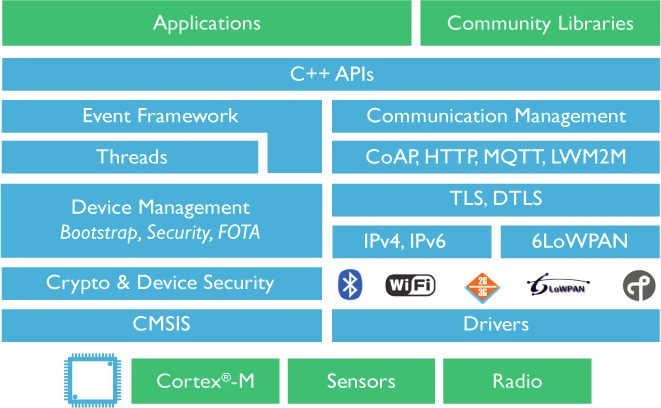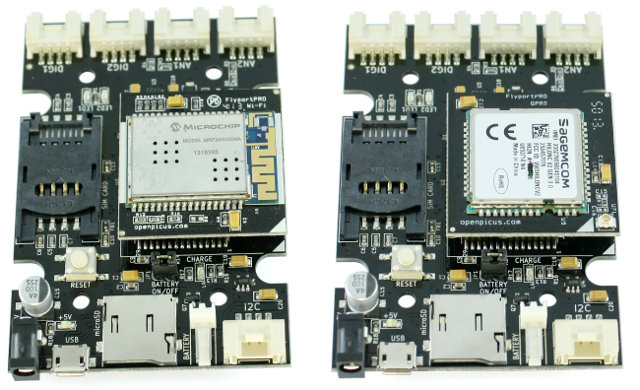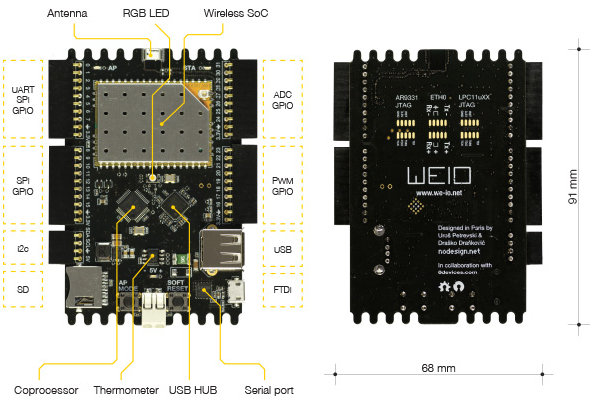Freescale has just launched a an IoT gateway reference design powered by their QorIQ LS1021A communication processors running Linux/OpenWRT, designed in partnership with TechNexion, and targeting various IoT applications such as building/home management, smart cities, networked industrial services, etc… Beside the dual core Cortex A7 QoirIQ processor, the board features six Gigabit Ethernet ports, two USB 3.0 ports, a SATA 3 port, two mini PCIe connector, an LVDS interface, HDMI output, Arduino UNO compatible headers, and various others expansions headers. LS1021A-IOT IoT gateway Specifications: SoC – Freescale QorIQ LS1021A dual core Cortex A7 communication processor @ 1 GHz (5,000 coremarks) MCU – Freescale Kinetis K20 Cortex M micro-controller System Memory – 1 GB DDR3L Storage – 1 Gb QSPI NOR Flash, SDHC slot (up to 32 GB) populated with a 4GB SD card, 1x mSATA 3 slot Connectivity – 6x Gigabit ports via SGMII (Serial Gigabit Media Independent Interface) and […]
ARM Announces mbed OS for ARM Cortex-M Micro-controllers and mbed Device Server for the Cloud
ARM has just announced two new software products for mbed development boards at ARM Techcon 2014: mbed OS, an operating system for Cortex-M MCUs, and mbed Device Server to handle IoT data in the cloud. Together with existing mbed hardware, these form what ARM now calls mbed IoT Device Platform. mbed OS is a free operating system for ARM Cortex-M processor with security, communication and device management features necessary to enable IoT devices. It will provide a C++ application framework, and the software stack includes support for Bluetooth Smart, 2G, 3G, LTE and CDMA cellular technologies, Thread, Wi-Fi, 802.15.4 / 6LoWPAN, TLS/DTLS, CoAP, HTTP, MQTT and Lightweight M2M. No need to look for your mbed board, planning to try it out just yet however, as mbed OS (alpha) will be available to partners in Q4 2014, and there will be alpha and beta releases during the course of 2015, before […]
CALAO Systems Introduces PInBALL Industrial Board Based on Raspberry Pi Compute Module
CALAO Systems has just launched an industrial single board computer (SBC) for professional Raspberry Pi developers called PiNBALL or, if you prefer, PAC-1210-S200-B2835-EXX…. The board is powered by the Raspberry Pi Compute Module, features interfaces such as two mini PCIe slots (for USB, I2C, GPIOs,…), fast Ethernet, HDMI, opto-isolated inputs and outputs, etc., +6 to +36V power input, and can operate in -20°C to +70°C temperature range. PInBALL industrial SBC specifications (Items marker with ‘*’ are optional, and depend on model): SoC / Memory / Storage – Via Raspberry Pi Compute Module – Broadcom BCM2835, 512MB RAM, 4GB eMMC Flash. Other Storage – 1x 2Kb I²C EEPROM with EUI-48 MAC Address & 128 bit Serial Number (AT24MAC402). Video Output – 1x HDMI Out, 1x CVBS Out (BCM2835) Audio Output – 1x HDMI, 2x S/PDIF Out / Optical & RCA (WM8804), Connectivity – 1x Fast Ethernet (LAN9514), 1x Micro-SIM Socket USB […]
openPicus Introduces Wi-Fi and GPRS IoT Kits Powered by Microchip PIC24 MCU
openPicus has launched two new development kits for the Internet of Things with either Wi-Fi or GPRS connectivity, based on their FlyportPRO modules featuring a 16-bit Microchip PIC24 MCU, and sharing the same baseboard. These kits can be used as a Web server with firmware update over the air (FOTA) (Wi-Fi version only) among other things, and support TCP, UDP, FTP, & HTTP protocols, as well as MQTT (Message Queue Telemetry Transport), a light weight messaging protocol running on top of the TCP/IP protocol, used when a small code footprint is required and/or network bandwidth is limited. openPicus FlyportPRO Wi-Fi and GPRS modules share mostly the same specifications: MCU – Microchip PIC24FJ256GB206 16-bit MCU @ 32 MHz with 256KB Flash, 96KB RAM External Storage – 16Mbit Flash memory (for FOTA), 64Kbit EEPROM Connectivity GPRS Module – SAGEM HILONC GPRS Transceiver (quad band: 850, 900, 1800, 1900 MHz) with uFL connector for external […]
STMicro STM32F7 Series is the First ARM Cortex-M7 MCU Family
Right after ARM’s Cortex-M7 announcement, STMicro has listed STM32F7 MCU family based on the latest ARM core on their website. The family is comprised of 20 different MCUs with various flash size, packages, and with or without a crypto/hash coprocessor. The company expects their STM32F756xx microcontrollers to be used for motor drive and application control, medical equipment, industrial applications such as PLC, inverters, and circuit breakers, printers & scanners, alarm systems, video intercom, HVAC, home audio appliances, mobile applications, Internet of Things application, and wearable devices such as smartwatches. STM32F7 MCUs share the following key features: Cortex-M7 core @ 200 Mhz (1000 CoreMark/428 DMIPS) with L1 cache (4KB I-cache, 4KB d-cache) 320KBytes of SRAM with scattered architecture: 240 Kbytes of universal data memory a 16 Kbytes partition for sharing data over the bus matrix 64 Kbytes of Tightly-Coupled Data Memory (DTCM) for time critical data handling (stack, heap…) 16 Kbytes […]
ARM Introduces Cortex-M7 MCU Core for IoT, Wearables, Industrial and Automotive Applications
ARM has just announced Cortex-M7 processor based on ARMv7-M architecture, with double the compute and digital signal processing (DSP) capability of ARM Cortex M4. The latest ARM MCU core targets IoT and wearables applications for the automotive, industrial, and consumer markets including motor control, industrial / home / factory automation, advanced audio, image processing, connected vehicle applications, and so on. Cortex-M7 comes with enhanced DSP instructions, a better FPU (FPv5 with single and double precision support), and tight coupled memory compared to Cortex-M4, according to an Anandtech article. ARM Cortex-M7 also achieves 5 CoreMark/MHz against 3.41 CoreMark/MHz for Cortex M4, and up to 3.23 DMIPS/MHz against up to 1.95 DMIPS/MHz. ARM Cortex-M7 features listed in the press release: Six stage, superscalar pipeline delivering 2000 Coremarks at 400MHz in a 40LP process. AXI interconnect (supports 64-bit transfer) and fully integrated optional caches for instruction and data allowing efficient access to large […]
Getting Started with LinkIt ONE Development Kit for Wearables & IoT
After going through WRTnode Quick Start Guide, it’s now time to play with LinkIt ONE, the IoT development board from Mediatek designed by Seeed Studio. LinkIt ONE is the first Hardware Development Kit (HDK) for Mediatek LinkIt, so there may be a LinkIt TWO, and/or other hardware platforms in the future. LinkIt ONE specifications Let’s quickly go through the specifications first: Processor – Mediatek MT2502A (Aster) ARM7 EJ-STM processor @ 260 MHz System Memory – 4 MB Storage – 16MB Flash for firmware + micro SD slot shared with SIM slot for up to 32GB additional storage Connectivity: Wi-Fi – 802.11 b/g/n (MT5931) with external antenna Bluetooth – BR/EDR/BLE(Dual Mode) GPS – Mediatek MT3332 with external antenna GSM/GPRS – 850/900/1800/1900 MHz band, Class 12 GPS with external antenna Audio – 3.5mm headphone jack (including mic support) – Support for MP3, AAC, and AMR codecs. Serial – Software Serial (Serial), and […]
WeIO is an Open Source Hardware IoT Board Programmable from a Web Browser (Crowdfunding)
WeIO is an open source hardware board for the Internet of things with Wi-Fi connectivity and lots of I/Os designed by nodesign, a French based startup, in collaboration of 8devices, the makers of the Carambola boards. WeIO is powered by an Atheros AR9331 SoC running OpenWRT as well as an NXP LPC MCU for faster handling of I/Os and support for analog I/Os. One interesting aspect of this board is that it can be programmed via a web browser using HTML5 or Python, and it does not rely on the Cloud to store data. WeIO hardware specifications: SoC – Atheros AR9331 MIPS 24K Wireless SoC @ 400 MHz MCU – NXP LPC11xx ARM Cortex M0 MCU for analog I/O and real-time H/W interfaces System Memory – 64 MB DDR2 Storage – 16 MB flash + micro SD slot Connectivity – 802.11 b/g/n Wi-Fi with on-board antenna (AP and STA modes), […]










